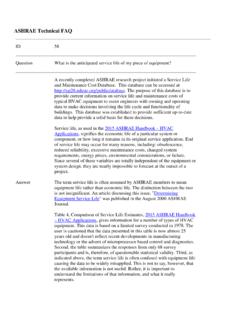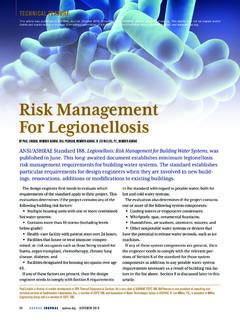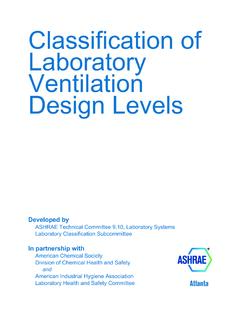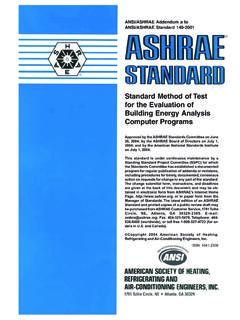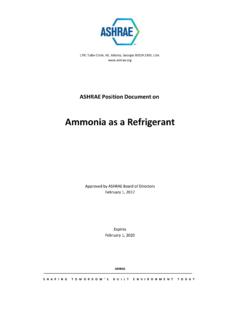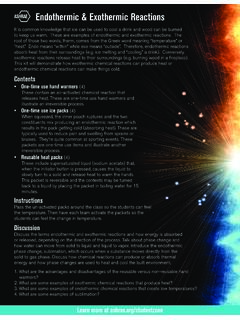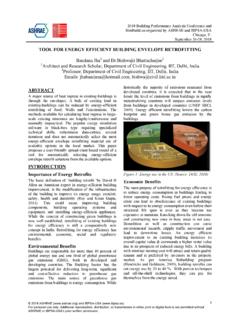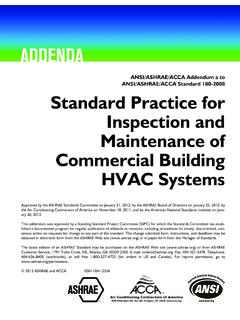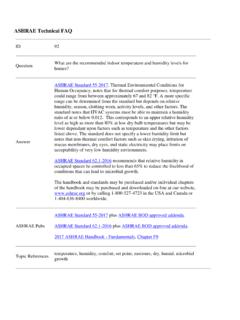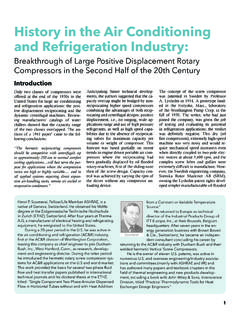Transcription of ANSI/ASHRAE Standard 52.2-2017
1 ANSI/ASHRAE Standard (Supersedes ANSI/ASHRAE Standard )Includes ANSI/ASHRAE addenda listed in Appendix HMethod of TestingGeneral VentilationAir-Cleaning Devicesfor Removal Efficiencyby Particle SizeSee Informative Appendix H for approval dates by the ashrae Standards Committee, the ashrae Technology Committee, andthe American National Standards Standard is under continuous maintenance by a Standing Standard Project Committee (SSPC) for which the StandardsCommittee has established a documented program for regular publication of addenda or revisions, including procedures fortimely, documented, consensus action on requests for change to any part of the Standard . The change submittal form,instructions, and deadlines may be obtained in electronic form from the ashrae website ( ) or in paperform from the Senior Manager of Standards.
2 The latest edition of an ashrae Standard may be purchased from theASHRAE website ( ) or from ashrae Customer Service, 1791 Tullie Circle, NE, Atlanta, GA : Fax: 678-539-2129. Telephone: 404-636-8400 (worldwide), or toll free 1-800-527-4723 (fororders in US and Canada). For reprint permission, go to 2017 ashrae ISSN 1041-2336 ashrae . Provided to the public as part of ashrae 'S COVID-19 response . Per international copyright law, additional reproduction, distribution, or transmission in either print or digital form is not permitted without ashrae 's prior written NOTEThis American National Standard (ANS) is a national voluntary consensus Standard developed under the auspices of ashrae . Consensus is definedby the American National Standards Institute (ANSI), of which ashrae is a member and which has approved this Standard as an ANS, as substantial agreement reached by directly and materially affected interest categories.
3 This signifies the concurrence of more than a simple majority,but not necessarily unanimity. Consensus requires that all views and objections be considered, and that an effort be made toward their resolution. Compliance with this Standard is voluntary until and unless a legal jurisdiction makes compliance mandatory through legislation. ashrae obtains consensus through participation of its national and international members, associated societies, and public Standards are prepared by a Project Committee appointed specifically for the purpose of writing the Standard . The ProjectCommittee Chair and Vice-Chair must be members of ashrae ; while other committee members may or may not be ashrae members, allmust be technically qualified in the subject area of the Standard . Every effort is made to balance the concerned interests on all Project Committees.
4 The Senior Manager of Standards of ashrae should be contacted fora. interpretation of the contents of this Standard ,b. participation in the next review of the Standard ,c. offering constructive criticism for improving the Standard , ord. permission to reprint portions of the uses its best efforts to promulgate Standards and Guidelines for the benefit of the public in light of available information and acceptedindustry practices. However, ashrae does not guarantee, certify, or assure the safety or performance of any products, components, or systemstested, installed, or operated in accordance with ashrae s Standards or Guidelines or that any tests conducted under its Standards or Guidelineswill be nonhazardous or free from INDUSTRIAL ADVERTISING POLICY ON STANDARDSASHRAE Standards and Guidelines are established to assist industry and the public by offering a uniform method of testing for rating purposes, bysuggesting safe practices in designing and installing equipment, by providing proper definitions of this equipment, and by providing other informationthat may serve to guide the industry.
5 The creation of ashrae Standards and Guidelines is determined by the need for them, and conformanceto them is completely referring to this Standard or Guideline and in marking of equipment and in advertising, no claim shall be made, either stated or implied,that the product has been approved by Standing Standard Project Committee TC: , Particulate Air Contaminants and Particulate Removal EquipmentSPLS Liaison: Rita M. HarroldMichael D. Corbat*, ChairDavid. B. Christopher*Phil Maybee*Kathleen Owen*, Vice-ChairJeron Downing*Stephen W. Nicholas*Todd A. McGrath*, SecretaryDara Marina Feddersen*Christine Q. Sun*Robert B. Burkhead*Chris Fischer*Paolo M. Tronville*Richard K. Chesson, Jr.* Sanjeev K. Hingorani* Kyung-Ju Choi*David Matier* * Denotes members of voting status when the document was approved for publicationASHRAE STANDARDS COMMITTEE 2016 2017 Rita M.
6 Harrold, ChairMichael W. GallagherCyrus H. NasseriSteven J. Emmerich, Vice-ChairWalter T. GrondzikDavid RobinJames D. AsweganVinod P. GuptaPeter SimmondsNiels BidstrupSusanna S. HansonDennis A. StankeDonald M. BrundageRoger L. HedrickWayne H. Stoppelmoor, B. CrawleyRick M. HeidenJack H. ZarourJohn F. Dunlap,Srinivas KatipamulaWilliam F. Walter, BOD ExOJames W. Earley, L. LimPatricia Graef, COKeith I. EmersonArsen K. MelikovJulie M. FergusonR. Lee Millies, C. Reiniche, Senior Manager of Standards ashrae . Provided to the public as part of ashrae 'S COVID-19 response . Per international copyright law, additional reproduction, distribution, or transmission in either print or digital form is not permitted without ashrae 's prior written Standard ,Method of Testing General Ventilation Air-Cleaning Devicesfor Removal Efficiency by Particle SizeSECTIONPAGEF oreword.
7 21 Definitions and Acronyms ..34 Test Apparatus Qualification Testing ..96 Test Selection and Preparation of the Test Test Measurement of Resistance versus Determination of Particle Size Reporting Minimum Efficiency Reporting Value (MERV) for Air Normative Appendix A: Appendix B: Test Procedure Suggestions and Appendix C: How to Read a Test Report ..38 Informative Appendix D: Minimum Efficiency Reporting Appendix E: Cross-Reference and Application Guidelines ..44 Informative Appendix F: Acronyms and Conversion Appendix G: Informative Appendix H: Addenda Description Appendix I: (Intentionally Left Blank)..49 Informative Appendix J: Optional Method of Conditioning a Filter Using Fine KCl Particles toDemonstrate Efficiency Loss That Might Be Realized in Field Appendix K: Optional Method of Testing Two Air Filters Arranged in Series in a System toEvaluate Particle Removal, Dust Loading, and Pressure Drop Increase ThatMight Be Realized in Field addenda, errata, or interpretations for this Standard can be downloaded free of charge from the ashrae website at 2017 ASHRAE1791 Tullie Circle NE Atlanta, GA 30329 All rights is a registered trademark of the American Society of Heating, Refrigerating and Air-Conditioning Engineers, is a registered trademark of the American National Standards Institute.
8 ashrae . Provided to the public as part of ashrae 'S COVID-19 response . Per international copyright law, additional reproduction, distribution, or transmission in either print or digital form is not permitted without ashrae 's prior written Standard (This foreword is not part of this Standard . It is merelyinformative and does not contain requirements necessaryfor conformance to the Standard . It has not been pro-cessed according to the ANSI requirements for a standardand may contain material that has not been subject topublic review or a consensus process. Unresolved objec-tors on informative material are not offered the right toappeal at ashrae or ANSI.)FOREWORDANSI/ ashrae Standard incorporates addenda tothe 2012 edition. The goal of the committee was to improvethe end-user experience by standardizing reporting orimproving the robustness of the test method to reduce vari-ability.
9 The committee s intentions were to provide the bestpossible information for the end user to select the best air-cleaning devices to protect people and , standards for testing air cleaners have beendeveloped in response to the needs of the times. Protection ofmachinery and coils came first, then reduction of soiling. Nowconcerns about indoor air quality and respirable particles,protection of products during manufacturing, and protectionof HVAC equipment have prompted development of this teststandard based on particle Project Committee (SPC) was first orga-nized in 1987 to develop a particle size test procedure but wasdisbanded in 1990 after it became evident that basic researchwas needed. In 1991, a research contract ( ashrae ResearchProject 671, Informative Appendix A, Reference A2) wasawarded to review test methodology and recommendapproaches for obtaining particle size efficiency data.
10 Afterthe research project was completed and accepted in 1993,SPC was reactivated with members representing a broadrange of interests. The Standard was then formally publishedin 1999. Changes to the method have been made over theyears to improve it and to make it more relevant. The 2017edition continues that tradition. Appendix H includes a fulllist of changes by addendum:a. Modifications were made to the MERV table to adjust thethreshold for specific MERVs and allow for the 16 gradu-ations to be more observable in To address user concerns about reproducibility and reli-ability of the test method, ashrae commissioned ResearchProject RP-1088, a comprehensive round robin of multiplelabs, including multiple levels of filtration changes in the 2017 edition of the Standard are basedon direct recommendations of the research Changes were made with the intent of making the data onreports more mandatory.
